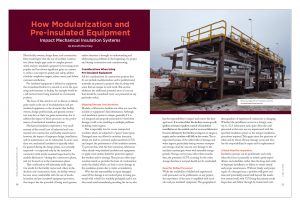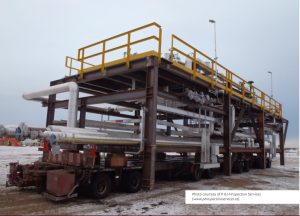How Modularization and Pre-insulated Equipment
Impact Mechanical Insulation Systems
Most facility owners, design firms, and construction firms would agree that the use of modular construction (from simple pipe racks to complex process units) and pre-insulated equipment is becoming more popular and has shown significant gains as a means to reduce cost, improve quality and safety, address schedule completion targets, reduce waste, and deliver customer satisfaction.
Pre-insulated equipment is defined as equipment that is insulated before it is erected or set in the operating unit/structure or facility. An example would be a tall vertical tower being insulated in a horizontal position.
The focus of this article is not to discuss or debate gains made in the use of modularization and pre-insulated equipment, or the obstacles that facility owners, design professionals, and general contractors may face as their use gains momentum, but to address the impact of those processes on the performance of mechanical insulation systems.
Mechanical insulation represents a very small amount of the overall cost of industrial and commercial new construction and facility maintenance; however, the impact of improper design, installation, and/or maintenance can be substantial. In more cases than not, mechanical insulation is typically taken for granted during the design phase, not normally inspected—or inspected only by the insulation contractor (with maybe nominal inspection by the module fabricator)—during the construction phase, and not focused on in the maintenance phase.
That combination will ultimately yield negative results for the facility owner and others in the decision and construction chain. As facility owners become more comfortable with the use of modularization and pre-insulated equipment processes, that impact has the potential of being much greater, unless attention is brought to understanding and addressing any problems in the beginning of a project and during construction and commissioning.
Considerations When Using Pre-insulated Equipment
All the considerations in construction projects that do not include modularization and/or prefabricated materials are present in projects that do, along with some that are unique to such work. This section addresses the additional potential areas of concern that should be considered (note: not presented in any particular order).
Shipping/Storage Considerations
Module or fabrication facilities are often not near the module or equipment’s final destination. Although each insulation system is unique, generally if it is not designed and properly protected for travel then damage could occur, resulting in multiple problems including water ingress.
This is especially true for ocean-transported modules, which are subjected to “green” water spray. Damaged areas can allow for moisture intrusion, which can lead to corrosion under insulation (CUI) and impact the performance of the insulation system. To prevent this, with the best intentions, fabricators often shrink-wrap finished modules and equipment or apply some similar shield for protection against the weather and/or damage. That process often traps moisture inside or provides the basis of condensation under the shield, which can lead to more damage to the insulation system due to water accumulation.
Who has the responsibility to repair damaged areas? If the damage is not noticed prior to being protected with a shield (or similarly packaged), and is not discovered until immediately preceding the tie-in, who has the responsibility to inspect and correct the damaged area? It is critical that the facility owner specify quality assurance/quality control of insulation installation at the module yard or overseas fabricator because ultimately the burden to inspect, re-inspect, repair, and re-insulate will fall on the owner. This is important because of the added risks of damage and water ingress, particularly during overseas transport and storage. And the concern over damage to the insulation system gets worse with extended storage periods. Storage can be years, rather than months; thus, the potential of CUI occurring for the entire storage duration is real and should not be overlooked.
Need for Skilled Personnel
While the availability of skilled and experienced craft personnel can be problematic on any project, the importance of the issue is amplified with modules and pre-insulated equipment. The geographical demographics of experienced contractors is changing. Whether the installation occurs in a foreign country or a U.S. fabrication yard, quite often the craft personnel in that area are not experienced with the specified insulation system or the unique installation procedures required. This again raises the questions of when and by whom did any damage occur, and who has the responsibility for repair and/or replacement?
Critical Need for Inspection
Insulation systems can be problematic and costly when the focus is primarily on initial capital expenditures and schedules, rather than the long-term risks of improper installation or failure to ensure timely and proper maintenance. Without timely and proper repair of a damaged area, a problem will grow over time and potentially extend well beyond the insulation system itself, with CUI being the primary result. Inspection and follow through by trained and certified mechanical insulation inspectors is essential before, during, and after installation to identify areas of non-compliance. Inspection should be conducted immediately after shipment, either before and/or after unloading, and at regular intervals during storage and before the system becomes operational. Once a damaged area is identified, regardless of where the responsibly lies, it is essential that timely and proper repair and/or replacement procedures be implemented to avoid damage spreading to a wider area.
Specification Compliance
As with any insulation system installation, it is critical to ensure utilization of the specified materials and installation procedures in accordance with the specifications. Often, an insulation system specified is modified without the design engineering company’s approval, which can impact the insulation system’s performance. The modification can be based on material availability, cost, contractor’s experience level, and a host of other items. An important point to remember is that an insulation system has many components, and a change of any one or more of those components can affect the performance and life of the insulation system. Unfortunately, in some cases, that impact may not be realized for months or years later. Concealed deterioration could result in the entire module or portions of it being rendered useless, which could require extensive repair or replacement.
Where and How Is Pre-insulated Equipment Used?
While many believe modularization and pre-insulated equipment are primarily used in the industrial market, that is not correct. The commercial market is equally engaged. The use of modular construction in the health-care, education, hospitality, multifamily housing, office, retail, and other market segments is widespread.
One example of equipment prefabrication would be an HVAC system that is continuing to gain ground in the U.S. commercial building space. This system utilizes variable refrigerant flow or variable refrigerant volume technology, as well as an evolved heat-pump technology with heat recovery systems and sub-cooling built in. The HVAC industry is using pre-insulated soft copper branch piping to each fan coil unit, where possible. This takes approximately 40% to 50% of the project out of the mechanical insulation trade. These parts of the system are often under-insulated from a thickness standpoint, and the insulation is improperly installed and damaged. A similar example is pre-insulated flexible duct insulation. The potential areas of concerns described earlier also are applicable in the commercial building sector, where the overall advantages (actual or perceived) of modularization and the use of pre-insulated equipment are attractive to many firms.
How to Ensure Best Use of Modular Construction/Pre-insulated Equipment
Because modular construction and the use of pre-insulated equipment are gaining popularity, it is important to know how to make sure their utilization works to the benefit of a project and not its detriment. The good news is that there are steps you can take to eliminate or mitigate any negative impacts.
First, where possible, examine the potential schedule and cost impacts and advantages of
insulating the equipment, etc. prior to installation versus in the fabrication yard, thus avoiding any transportation and storage-related concerns. With that, understand the benefits and challenges of insulation system design and material selection associated with module fabrication, shipment, storage, and project site location.
Ensure the insulation system—including substrate preparation, protrusions, and termination points—is designed to withstand the rigors of transportation, storage, and the tie-in process. For above-ambient operating systems, consider incorporating a drainage system—particularly for horizontal vessels—so that water entering the insulation system is able to escape. The design of below-ambient insulation systems is particularly critical because they are more complex and are designed to prevent moisture ingress. As an example, if any caulking or vapor stops are installed incorrectly, or damage is incurred, there becomes a potential point of entry for water, which can then become trapped under the insulation.
Ensure that any protective shield system for shipping will not create more damage than it prevents. Implement an inspection process before any protective shield is installed, after installation, after shipment, during storage, and prior to tie-in. Clearly identify insulation system deficiencies and work not completed prior to shipping, and ensure correction of those items before the module is released for shipment.
Implement and maintain a process for ensuring the insulation company and craft personnel are trained and experienced with the specific insulation system, and make sure that adequate and continual supervision is provided. This may require site training for personnel—from installers through supervision and inspection personnel.
Implement a thorough inspection process, executed by trained and certified mechanical insulation inspectors, from the review of material submittals through material storage, installation, and project completion.
Ensure insulation system repair and replacement procedures have been developed, approved, and executed in a timely manner if damaged areas are discovered.
Conclusion
The value of mechanical insulation systems is often overlooked and undervalued in many industrial and commercial construction projects and existing facilities. Modularization and pre-insulated equipment processes are no different and potentially could be the foundation for creating multiple challenges if not addressed. The solution is easier said than done, but the reality is that if more focus is not placed on the mechanical insulation system before, during, and after installation, the advantages of using pre-insulated equipment—indeed, of the insulation system itself—will be reduced or offset by future costs. Will increased focus on mechanical insulation systems come with a cost? Yes. But a higher initial cost is more than offset by the potential for likely increased operating, repair, and/or replacement costs in the end.
The reasons for consideration and use of modularization and pre-insulated equipment are not in dispute; but where the use of mechanical insulation is required, increased attention also is required to avoid increased short- and potential long-term costs and operational interruptions.
The author would like to express his appreciation to Ed Schauseil, Subject Matter Expert–Insulation and Coatings, KBR, Houston, Texas, and Mark Scott, Stationary Equipment Engineer, LyondellBasell, Houston, Texas, for their help in reviewing and providing suggestions for this article. Their insight on this topic and commitment to improving mechanical insulation specifications and applications throughout the industry is an example for others to follow.


